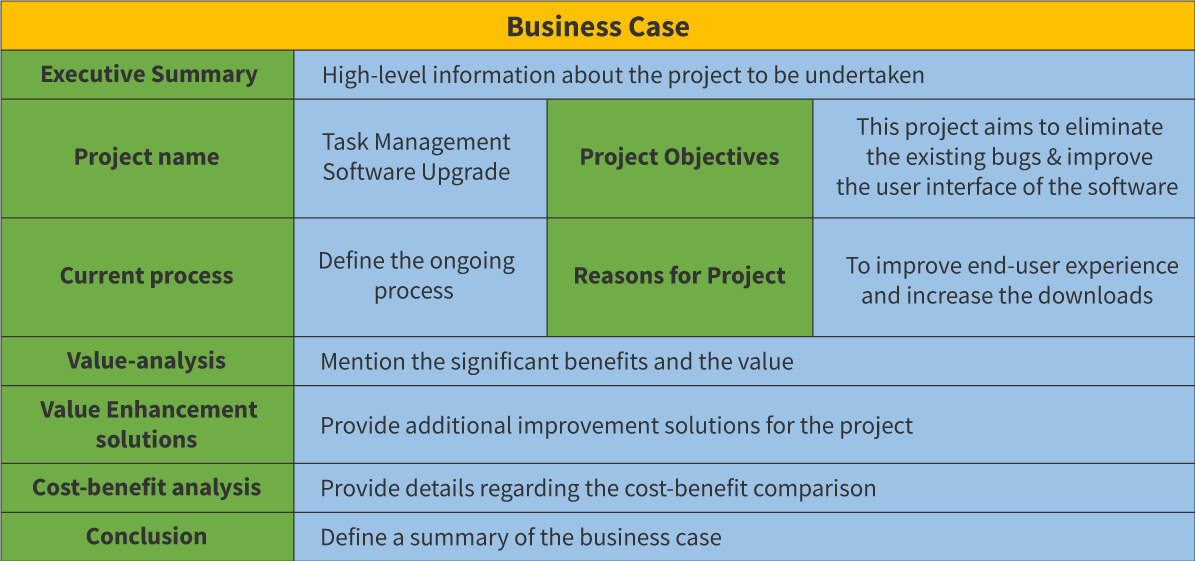Let’s say you are proposing a new product or a process improvement or upgrade to the stakeholders. How will you convince them?
Indeed, you will start by explaining the project’s purpose, its value proposition and strategic alignment, cost-benefit analysis, and most importantly, if it’s solving any existing problem.
The following pertinent question is- How will you consolidate all this information in one document?
The solution is forming a systematic business case.
A business case essentially justifies a proposed project or a solution to a prominent issue. Thus, it helps define every critical attribute of the proposition and facilitates stakeholders to objectively evaluate and analyze every aspect.
However, to write a compelling business case, one must note the key elements to be included and do a thorough research of the project. This blog explains the steps you must take to formulate a business case that the senior management or stakeholders will accept.
But before we go there, let’s understand its significance.
What is the significance of a business case?
A business case, in its essence, is a document that presents a new project and its benefits, or it explains a problem and the viable strategies that can be undertaken to resolve it. The document also points out the specific rationale that goes behind the process. It helps the stakeholders understand the ROI and value benefits of the proposition. Additionally, it provides an evidence-based framework for decision-makers to reach a data-driven conclusion.
Moreover, a business case allows you to present the idea in a story format to make it more personalized. This enables the executives to relate with the concept better and thus, enhances their engagement.
Additionally, a business case entails multiple solutions to a particular problem. Thus, stakeholders or the upper management can perceive it from different angles. Besides this, if they disagree with one solution, you still have a plan B to convince them, which increases the chances of agreement. This is why a business case plays an integral role in getting an executive buy-in.
Thus, you need to know how to frame a business case that wins over everyone’s trust. The following section explains the necessary action steps.
Read More: How Can You Make Data-Driven Decisions with Resource Management Software?
How to write a business case?
As discussed above, a business case must be well-researched and presented as a story to grab the audience’s attention and make it more relatable. Here are some proven strategies you can implement to do so:
Perform extensive background research
For a business case to serve its purpose, it must capture all facets of the project, such as the cost, ROI, timeline, risks, etc. Thus, one should do extensive research before writing it. They can start by studying previous similar projects, understand the mistakes, the success points, and so on. A comprehensive analysis will help you deduce the best solutions with minimal loopholes and, at the same time, enhance your confidence during the presentation.
After conducting the research, you can align the facts and figures with the organization’s vision and plans in mind. This helps the stakeholders understand the case better, and there’s a higher chance they’ll concur with you.
Take expert judgment and perform brainstorming sessions
It’s safe to say that many seasoned project managers or other authorities must have taken up similar projects within the organization. As the famous adage goes, ‘Experience is the best teacher,’ you can seek expert advice and judgment and learn from their mistakes. That way, you can create a more viable business case and avoid making the inaccuracies made during the previous projects.
For example, let’s consider a situation where you are creating a business case for a software update project. While doing that, you can consult with the senior IT team members or other veteran project managers who have been part of similar projects. You can have brainstorming sessions or one-on-one meetings and take a better information-driven approach while formulating the case.
Point out case studies and data that solidify the case
As you frame the business case, provide adequate case studies where businesses have implemented your proposed idea and reaped its rewards. This helps you to generate greater leverage for your business case.
You can enlist the direct and indirect competitors doing well with their versions of your proposed changes. Besides, you may also mention some of your previous solutions, which proved beneficial in solving other problems. It will help increase your credibility and solidify your take on the business case. By establishing accurate precedents and presenting verifiable data, you can convince the stakeholders that implementing the particular project will increase the organization’s returns.
Tell a compelling story around the new initiative
A robotic business case with only numbers or solutions can lower the audience’s attention span. Thus, you must take a creative approach and prepare it in the story format. It will help you add a CTA in the form of moral towards the end and make it more personalized and engaging. Hence, while presenting the case, try to use multiple examples, analogies, and short anecdotes to explain the values and benefits in the most fascinating yet comprehensible manner.
For example, let’s consider that your product in the spotlight is already generating high revenues. However, you found that the product can procure better revenue through an update. But since the gains are already high, talking about any changes to the current model may not prove convincing for the stakeholders. Thus, you may need to create a story that shows a consumer benefitting from the update to prove your point and ensure their buy-in.
Read More: 7 Steps to Write an Effective Project Proposal
Simplify the business case
Upper management officials are busy with multiple activities throughout the day and do not have much time in their hands. Hence, you must present a simplified business case, which explains everything in a crisp and concise manner. If possible, try to bring the main idea of your business case down to one line. That way, your vision becomes more transparent for the key decision-makers.
Moreover, you may simplify the business case by using pictorial representations wherever necessary. Graphs, charts, diagrams, etc., can be even more helpful in making the stakeholders visualize the solution’s benefits. Lastly, refining and proofreading the document is also necessary. As you create multiple business case sections, go back and forth numerous times to ensure that everything has been accounted for in the document with no jargon or errors.
These are some key points that you should consider while creating the business case. Now let’s look at some of the components you can include.
What should you include in the business case?
Your business case document must be flawless, well researched, and have a convincing tone to win over the key personnel. These ideas will allow you to get the executive approval:
The purpose of the business case
While creating the business case, defining the purpose is of utmost importance. That way, the stakeholders will get a clear picture of why the business case is presented in the first place. The goal should explain the intention behind the case, or if it’s a problem-based approach, it should explain the intent to resolve it. It will help you create a compelling argument about the business case and set the stage for moving forward.
Remember that you prepare this section while keeping in mind the needs and priorities of the stakeholders to whom you’ll be presenting. Then you explain how it helps you attain the strategic objectives and how the stakeholders can measure its success. Also, ensure that the business case aligns with the company’s vision.
Read More: What is the Strategic Alignment of Portfolio, and Why is it Important?
A thorough value analysis
After the purpose of the proposition is clarified, the next step is to conduct and elucidate the value analysis. The value analysis entails the target audience (can be clients or stakeholders) and the benefits of the proposition.
For instance, let’s consider that you are proposing a business case about creating an immersive ad for your internal product. While presenting the case, you may point out the benefits such as increased sales, more registrations, lead conversions, etc. With the benefits in place, the stakeholders will understand the return value of the proposition, and the chances of approval would be higher.
Potential value-enhancement solutions
Value enhancement is defined when there is more scope of improvement to the current plan. For instance, if you propose a business case to fix bugs in your existing software. However, along with debugging, another feature can be added to the app. Let’s say that you want to add a feature using Augmented Reality to your e-Commerce app. The integration of AR will level up the consumer experience and maximize sales. Resultantly, it will increase the revenue of the company. This will enhance the value of the potential business case and increase your chances of getting the stakeholders on board.
However, it is advisable to list the possible value-enhancement solutions together and mention their respective pros/cons and other associated risks. You can also mention the assumptions you have made while framing them. It will help cover all the angles and assist the stakeholders in zeroing in on the best solution.
Cost-benefit analysis of the project
After explaining the key benefits or solutions, the next step is to describe the financial return. A cost-benefit analysis is one of the most practical ways to factor in tangible and intangible benefits. You can start by estimating the costs and resources needed for each of these solutions that you propose. In addition, you may also break down each component of the proposed solution and show where the funds will be channeled. For example, you can mention the cost of the human resources, tools, licenses required from local authorities, etc.
The next step is to calculate the expected return on investment. Ensure that you clearly explain the process you used while calculating the returns. Furthermore, since there will be significant use of organizational resources, mention how the cash flow will be affected. The use of resources will negatively impact cash flow, as money is being spent. However, you can generate a positive cash flow since the project aims to gain a higher rate of return in the future.
Read More: How to Select the Best Software Using Cost-Benefit Analysis?
The conclusion of the case
After everything is said and done, you should include a conclusion section at the end of the business case. It will summarize the whole case and allow the stakeholders to understand its gist.
Resultantly, the stakeholders’ approval chances will get even higher. Following this, the project sponsor can start creating the project charter when the business case gets approved.
To add value to this article and make it easy to comprehend, we have added a sample business case that you can use for future reference.
Sample business case
Here is an example of a business case for reference:
Disclaimer: – It’s a sample business case and only explains some aspects of a project. In reality, the project will have numerous solutions and more details.

Conclusion
A business case is a detailed outline of the project. Using it, you can get the stakeholders’ approval in no time and take on the new venture.
But to do that, you will have to include specific and correct details that make your business case look comprehensive, well designed, and simpler to achieve.
A solid business case, which comes with a well-rounded story and presents necessary but positive changes for the business, will quickly be ratified by the executives.
What strategies do you follow for creating a business case?
The Glossary
Read More: Glossary of Resource Workforce Planning, Scheduling and Management
SAVIOM Solution
SAVIOM has over 20 years of experience helping multinational clients manage their resources efficiently and effectively. With over 20 years of experience, this Australian-based MNC has a global presence across 50 countries and has helped 100+ clients meet their specific business goals. Saviom also provides tools for project portfolio management, professional service automation, and workforce planning software. So, SAVIOM can help your business establish an efficient system geared towards your specific business challenges.












